Why Artificial Intelligence in Cybersecurity Is Essential for Modern Enterprises
Is your enterprise prepared for AI-powered cyberattacks? This complete guide examines how artificial intelligence strengthens cybersecurity defenses across every digital touchpoint. Learn how machine learning detects threats in milliseconds, how AI adapts to evolving attack patterns, and why automation reduces human error.

In today’s digital-first world, cybersecurity has become a critical priority for businesses, governments, and individuals alike. With cyberattacks growing in sophistication and frequency, traditional security measures are no longer enough to protect sensitive data and digital infrastructure. This is where Artificial Intelligence (AI) is transforming the cybersecurity landscape.
AI empowers organizations to detect threats in real time, analyze vast amounts of data, and respond to attacks faster than human teams alone could manage. From identifying unusual network behavior to preventing phishing and ransomware attacks, AI is helping security teams stay one step ahead of cybercriminals.
The impact of AI in cybersecurity is enormous, and the market reflects its growing importance. As per Statista, the AI cybersecurity market is projected to grow from over $30 billion in 2024 to $134 billion by 2030. This rapid growth highlights the increasing reliance on intelligent, automated systems to safeguard digital assets.
In this blog, we’ll explore how AI is being applied in cybersecurity, its key components and applications, the benefits it offers, challenges organizations may face, and practical steps for implementing AI-driven security solutions.
What Is Artificial Intelligence in Cybersecurity?
Artificial Intelligence (AI) in cybersecurity refers to the use of advanced algorithms, machine learning, and data-driven models to detect, analyze, and respond to cyber threats automatically. Unlike traditional security measures that rely heavily on human monitoring, AI systems can process massive amounts of data in real time, identifying patterns and anomalies that may indicate potential attacks.
At its core, AI enhances cybersecurity by enabling systems to learn from past incidents, predict potential threats, and adapt to emerging attack techniques. For example, AI can detect unusual login attempts, identify ransomware behavior, or flag phishing emails before they reach users’ inboxes.
An emerging trend in this space is agentic AI, where AI systems can autonomously take actions to mitigate threats without waiting for human intervention. These AI agents can isolate infected devices, block suspicious network traffic, or execute predefined response protocols in real time, significantly reducing response time and limiting potential damage.
Key Components of AI in Cybersecurity
AI-powered cybersecurity isn't just one technology working alone. It's a combination of sophisticated components that work together seamlessly. Each element plays a crucial role in detecting, analyzing, and neutralizing cyber threats.
1. Machine Learning Algorithms
Machine learning algorithms form the backbone of AI cybersecurity systems. These algorithms analyze historical attack data to identify patterns and predict future threats. They continuously learn from new data, improving their accuracy with every interaction.
Unlike static security rules, machine learning automatically adapts to evolving attack methods. This means your defenses get smarter as hackers develop new tactics.
2. Natural Language Processing (NLP)
Natural Language Processing helps AI understand and analyze human communication patterns. It scans emails, chat messages, and social media to detect phishing attempts and social engineering attacks.
NLP identifies suspicious language, fake sender addresses, and malicious links hidden in text. This component is particularly effective at catching threats that target your employees directly. It reads between the lines to spot deception.
3. Neural Networks and Predictive Analytics
Neural networks mimic the human brain to recognize complex patterns of threats. They process massive datasets to predict where and when attacks might occur. Predictive analytics takes this further by forecasting vulnerabilities before hackers exploit them.
These deep learning systems spot zero-day threats that have never been seen before. They give your security team a crystal ball for cyber defense.
Together, these components create a multi-layered defense system that remains vigilant at all times. They work in harmony to provide comprehensive protection against sophisticated cyber threats.
How Artificial Intelligence Enhances Cybersecurity
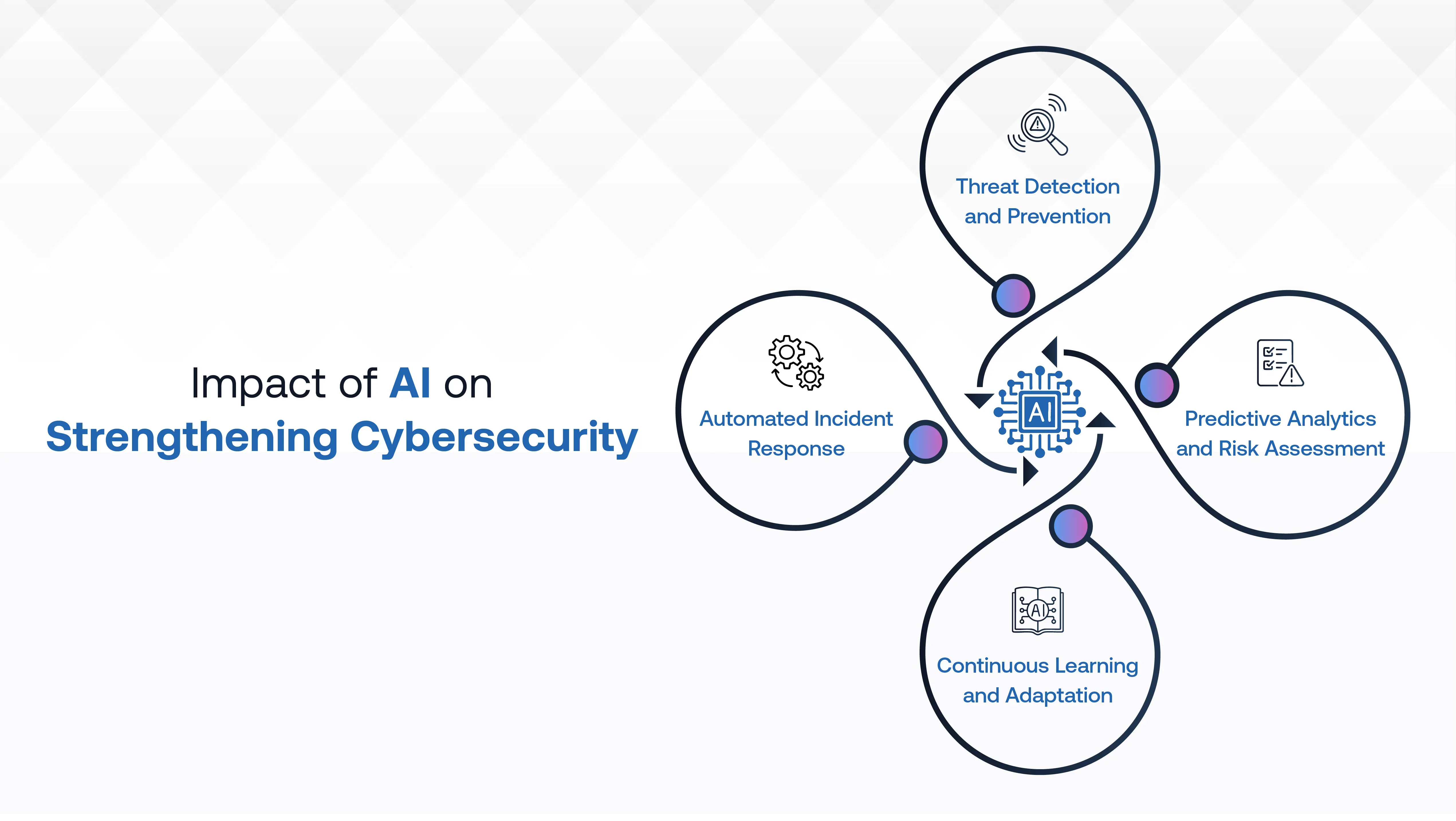
AI doesn't just add another layer to your security stack. It fundamentally transforms how your organization detects, responds to, and prevents cyber threats. From real-time monitoring to predictive defense, AI addresses security challenges at every stage of the process.
1. Threat Detection and Prevention
- AI continuously monitors your network traffic, scanning every byte of data in real-time.
- It identifies unusual patterns and behaviors that signal potential attacks.
- Advanced malware and ransomware get detected before they execute their payload.
- AI stops phishing emails and social engineering attempts by analyzing sender behavior.
- This proactive surveillance catches threats that traditional security tools miss entirely.
2. Automated Incident Response
- AI triggers response playbooks tailored to specific attack types automatically.
- Response times shrink from hours to mere seconds, allowing breaches to be contained before they spread.
- Automation reduces your dependence on manual intervention during critical moments.
- Your security team can focus on strategy while AI handles the neutralization of immediate threats.
- Incidents get resolved faster with minimal human involvement required.
3. Predictive Analytics and Risk Assessment
- AI anticipates vulnerabilities before hackers have a chance to exploit them.
- It prioritizes threats based on severity and likelihood of attack.
- The system identifies high-risk endpoints and users who might be targeted next.
- This forward-looking approach shifts your security from a reactive to a proactive stance.
- You fix weaknesses before they become entry points for attackers.
4. Continuous Learning and Adaptation
- AI systems improve constantly by learning from every new threat they encounter.
- Adaptive algorithms evolve in response to changing attack patterns and evolving hacker techniques.
- Each blocked attack makes your defenses more innovative and more resilient.
- Unlike static security rules that become outdated, AI stays current automatically.
- Your protection grows stronger with time, not weaker.
These capabilities work together to create an intelligent security ecosystem. AI handles the speed and scale that human teams simply cannot match. Now that we know how AI enhanced cybersecurity, let’s explore its applications to understand the concept better.
[[cta]]
Key Applications of AI in Cybersecurity
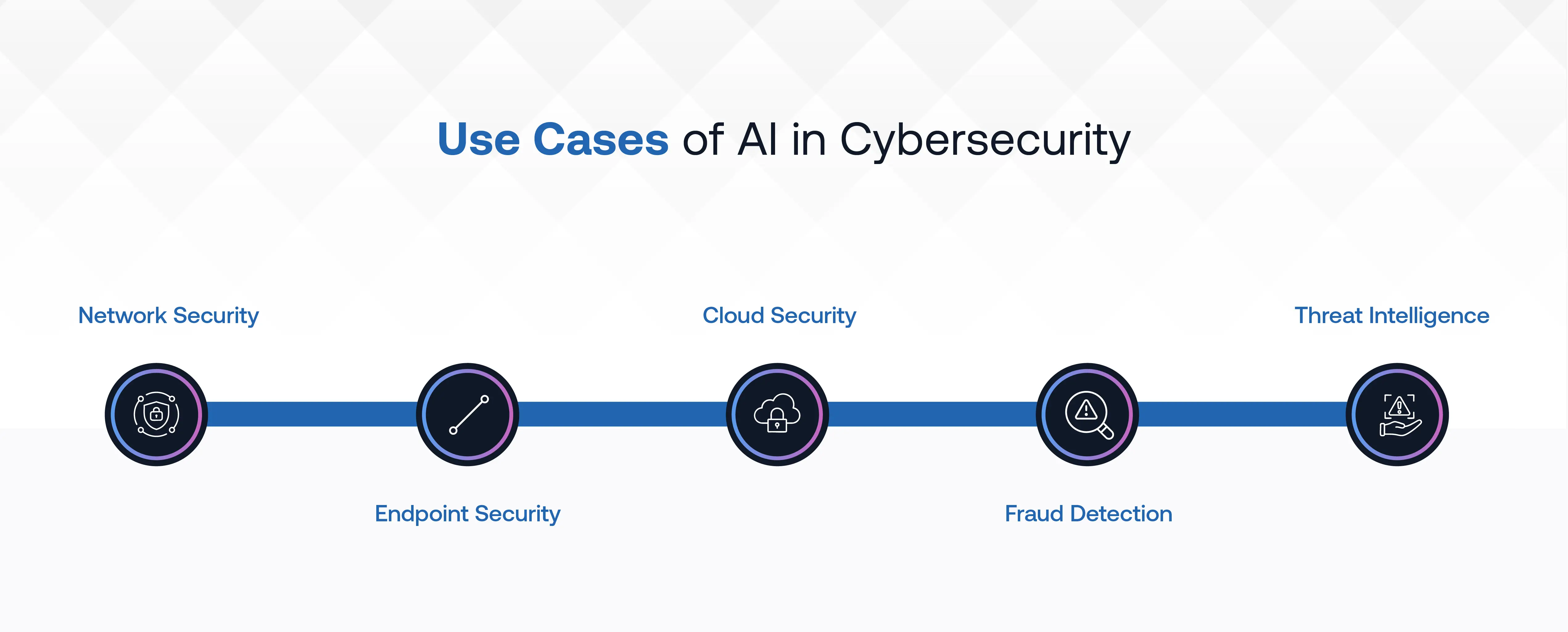
While AI is revolutionizing the application of AI in Physical Security, its impact on cybersecurity is equally transformative. From network perimeters to cloud infrastructure, AI applications are deployed where digital threats emerge. Here are the five critical areas where AI makes the most significant security impact in the cyber realm.
1. Network Security
- AI-Powered Intrusion Detection Systems (IDS): These systems scan your network continuously for unauthorized access attempts. They spot intrusion patterns that traditional firewalls miss completely.
- Monitoring and Filtering Suspicious Traffic: AI analyzes millions of data packets per second in real time. It identifies malicious traffic hidden among legitimate user activity. Suspicious connections are automatically blocked before they reach your systems.
- Detecting Zero-Day Vulnerabilities: AI identifies previously unknown exploits by analyzing attack behavior rather than signatures. It catches threats that have never been documented before, ensuring continuous prevention from advancing hackers.
2. Endpoint Security
- AI-Driven Antivirus and Anti-Malware Solutions: Modern endpoint protection utilizes AI to detect malware without relying on virus definitions. These solutions analyze file behavior and code structure to identify threats. They protect against polymorphic malware that constantly changes its signature.
- Protecting Devices from Evolving Threats: AI secures laptops, servers, and mobile devices against sophisticated attacks. It adapts to new threat types without requiring manual updates. Your entire device fleet stays protected as threats evolve.
- Detecting Abnormal User Behavior: AI establishes baseline behavior patterns for each user and device, enabling the identification of anomalies. It flags unusual activities, such as abnormal login times or excessive data access. This catches compromised credentials and insider threats immediately.
3. Cloud Security
- Securing Cloud Workloads and Storage: AI monitors your cloud infrastructure for misconfigurations and vulnerabilities, providing proactive protection. It ensures data stored in the cloud remains encrypted and protected. Cloud resources get continuously scanned for security gaps.
- Monitoring Cloud Access Patterns: AI tracks who accesses your cloud resources and when they do it. It identifies suspicious access attempts from unusual locations or devices. Unauthorized access gets blocked before sensitive data is exposed.
- Detecting Compromised Accounts and Insider Threats: AI spots when attackers are misusing legitimate credentials. It recognizes insider threats through unusual data download patterns or privilege escalation. Your cloud environment stays secure from both external and internal risks.
4. Fraud Detection
- Monitoring Financial Transactions in Real-Time: AI analyzes every transaction as it occurs, identifying potential fraudulent patterns. It identifies anomalies in spending behavior, transaction locations, and amounts. Suspicious transactions get flagged or blocked within milliseconds.
- Detecting Identity Theft and Unauthorized Access: AI recognizes when stolen credentials are used to access financial accounts. It analyzes device fingerprints, location data, and behavioral patterns simultaneously. Identity thieves get stopped before they can drain accounts.
- Reducing False Positives with Intelligent Analysis: Traditional fraud detection systems generate too many false alarms, which can frustrate customers. AI dramatically reduces false positives by understanding context and legitimate behavior.
5. Threat Intelligence
- Aggregating Global Threat Data: AI collects and analyzes threat information from millions of sources worldwide. It identifies emerging attack campaigns targeting specific industries or regions. Your security team gets a comprehensive view of the threat landscape.
- Predicting Emerging Attacks and Attack Vectors: AI analyzes historical attack data to forecast future threat trends. It identifies which vulnerabilities hackers are likely to target next. This foresight allows you to strengthen defenses before attacks occur.
- Sharing Actionable Insights: AI translates raw threat data into clear, actionable recommendations for your team. It prioritizes threats based on relevance to your specific infrastructure. Security teams receive actionable intelligence.
These applications demonstrate AI's versatility across your entire security infrastructure. Each area benefits from AI's speed, accuracy, and ability to learn continuously. Together, they create a comprehensive defense strategy that adapts to any threat. Now that we know how businesses can use AI to enhance cybersecurity, let’s understand the benefits of doing so.
5 Benefits of Using AI in Cybersecurity
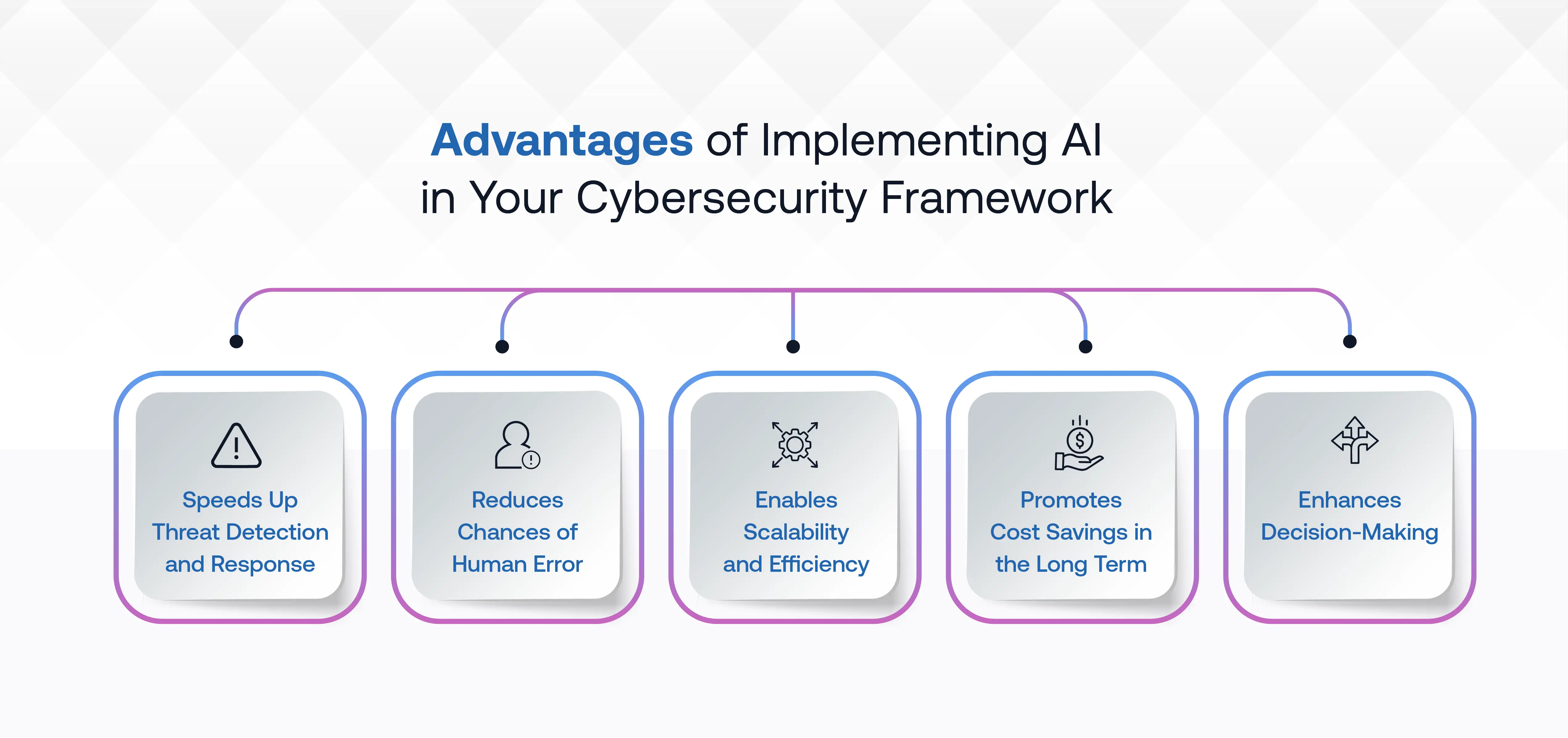
AI delivers measurable advantages that directly impact your bottom line and security posture. These benefits explain why enterprises are rapidly adopting AI-powered cybersecurity solutions.
1. Speeds Up Threat Detection and Response
AI dramatically reduces the time between detecting a threat and neutralizing it. Traditional security methods take hours or even days to identify and respond to attacks. AI completes this process in seconds, minimizing the window of vulnerability.
This speed drastically reduces the impact of breaches on your operations and data. Faster response means less damage, fewer compromised systems, and lower recovery costs for your organization.
2. Reduces Chances of Human Error
Human analysts get tired, miss alerts, and make mistakes during repetitive monitoring tasks. AI automates these monotonous security checks without losing focus or accuracy. It never experiences fatigue or overlooks suspicious activities buried in mountains of data.
By eliminating human oversight from routine tasks, AI catches threats that tired security teams might miss. Your security posture becomes more reliable and consistent around the clock.
3. Enables Scalability and Efficiency
AI monitors large networks and multiple endpoints simultaneously without breaking a sweat. As your organization grows, AI scales effortlessly to protect additional systems and users. It handles increasing data volumes and complexity that would overwhelm human teams.
This scalability makes AI suitable for organizations of all sizes, from startups to enterprises. You get enterprise-grade security without proportionally increasing your security staff.
4. Promotes Cost Savings in the Long Term
Implementing AI requires upfront investment, but the long-term savings are substantial. AI reduces the need for large security teams to manually monitor systems. It prevents costly data breaches that can result in millions of dollars in losses and fines.
Downtime caused by cyberattacks gets minimized, protecting your revenue streams. Over time, AI pays for itself many times over through prevention and efficiency.
5. Enhances Decision-Making
AI provides actionable insights that enable your IT team to make more informed security decisions. It analyzes threat patterns and presents clear recommendations for strengthening your defenses.
Security leaders can prioritize investments based on actual risk rather than guesswork. This data-driven approach ensures that resources are allocated where they're needed most. Your security strategy becomes more strategic and less reactive.
These benefits demonstrate why AI has become a game-changer in the field of cybersecurity. The combination of speed, accuracy, scalability, cost efficiency, and intelligence is unmatched. However, while AI is extremely useful in cybersecurity, it comes with its own implementation challenges. The coming section highlights these challenges.
[[cta-2]]
Challenges and Limitations of Artificial Intelligence in Cybersecurity
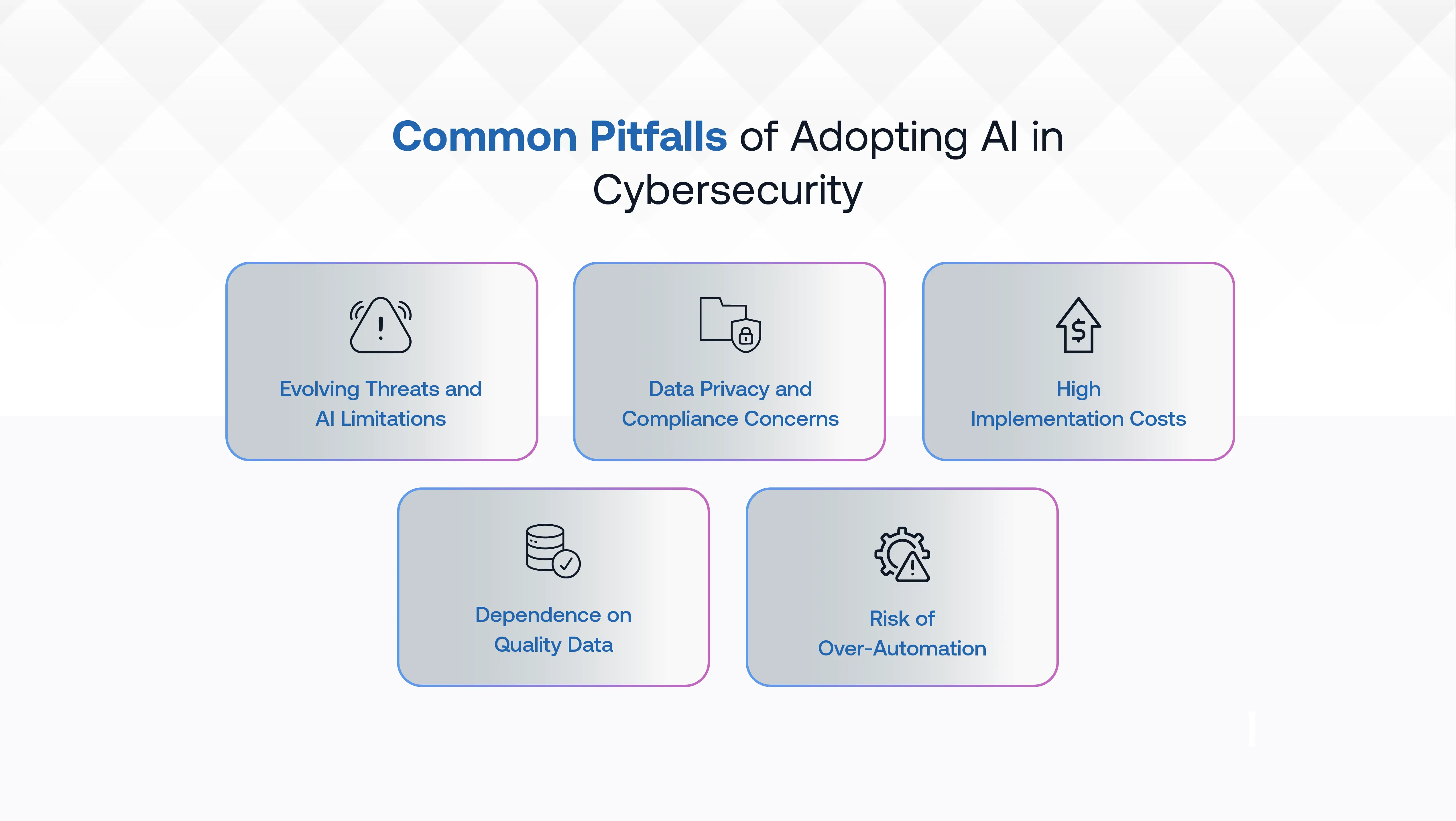
Every technology has limitations, and AI in cybersecurity is no exception. Understanding these challenges helps you implement AI more effectively and avoid potential pitfalls. Let's explore the key obstacles and how to address them.
1. Evolving Threats and AI Limitations
Problem Statement
Cybercriminals are now using AI to create more sophisticated attacks. They develop AI-powered malware that adapts and evolves to bypass detection systems. AI struggles to detect completely novel attack patterns that it has never encountered before.
Attackers constantly find new ways to exploit AI's blind spots. This creates an ongoing arms race between defensive and offensive AI systems.
How to Overcome This Challenge
- Combine AI with human expertise to catch what algorithms miss.
- Update AI models regularly with the latest threat intelligence to ensure optimal performance and security.
- Use multiple AI systems with different detection approaches for redundancy.
- Implement adversarial testing to identify AI vulnerabilities before attackers do.
- Maintain traditional security layers alongside AI as backup protection.
2. Data Privacy and Compliance Concerns
Problem Statement
AI systems need access to vast amounts of data to function effectively. This data often includes sensitive customer information, employee records, and confidential business data. Organizations must comply with stringent regulations, such as GDPR and CCPA, as well as industry-specific requirements.
Balancing AI's data needs with privacy obligations creates significant legal and ethical challenges. One compliance violation can result in massive fines and reputation damage.
How to Overcome This Challenge
- Implement data anonymization and encryption before feeding information to AI systems to ensure privacy and security.
- Conduct regular privacy impact assessments for AI security tools to ensure compliance with relevant regulations and ensure data protection.
- Choose AI vendors that prioritize compliance and offer built-in privacy features.
- Establish clear data governance policies that define what AI can access.
- Train your team on compliance requirements specific to AI implementations.
3. High Implementation Costs
Problem Statement
Deploying AI cybersecurity solutions requires substantial upfront investment. You need specialized infrastructure, powerful computing resources, and premium software licenses. Training your staff to work with AI systems adds additional costs.
Integrating AI with your existing security stack can be complex and expensive. These financial barriers prevent many organizations from adopting AI despite its benefits.
How to Overcome This Challenge
- Start with cloud-based AI solutions that reduce infrastructure costs and expenses.
- Implement AI gradually, beginning with high-priority security areas.
- Leverage managed security service providers who offer AI capabilities.
- Calculate ROI by factoring in breach prevention and efficiency gains.
- Explore open-source AI security tools for budget-conscious implementations.
4. Dependence on Quality Data
Problem Statement
AI is only as good as the data it learns from. Poor quality, incomplete, or biased datasets lead to inaccurate threat detection. Insufficient training data causes AI to generate false positives that overwhelm security teams, leading to a significant increase in false alarms.
False negatives are even more problematic, as they allow real threats to slip through undetected. Organizations often struggle to gather enough quality data to train AI effectively.
How to Overcome This Challenge
- Invest in comprehensive data collection and data cleaning processes before training with AI.
- Use threat intelligence feeds to supplement your internal data.
- Regularly audit AI performance and retrain models with corrected data.
- Implement data validation checks to ensure input quality remains high.
- Partner with security vendors who provide pre-trained models built on extensive datasets.
5. Risk of Over-Automation
Problem Statement
Over-relying on AI can create dangerous blind spots in your security posture. Automated systems might make critical decisions without proper human oversight. Security teams may become complacent, trusting AI too much and investigating too little.
An important context that humans understand gets lost when everything is automated. This over-dependence reduces your ability to handle unusual situations that AI wasn't trained for.
How to Overcome This Challenge:
- Maintain human-in-the-loop protocols for critical security decisions.
- Set up alerts that require human approval before taking significant actions.
- Train security teams to question and validate AI recommendations.
- Establish clear escalation procedures when AI encounters uncertain situations.
- Conduct regular exercises that involve humans overriding AI to maintain decision-making skills.
While these challenges are real, they're not insurmountable. Organizations that address these limitations strategically can harness AI's power while minimizing risks. The key is implementing AI thoughtfully with proper safeguards and human oversight. The coming section discusses how to integrate AI in your cybersecurity framework with minimal hassle.
How Businesses Can Implement AI in Cybersecurity
Cybersecurity AI Implementation doesn't have to be overwhelming or disruptive. A structured approach ensures smooth adoption and maximizes your AI investment. Follow these four essential steps to deploy AI-powered cybersecurity in your organization successfully.
1. Assess Current Security Posture
- Conduct a comprehensive audit of your existing security infrastructure.
- Identify vulnerabilities, gaps, and areas where threats consistently slip through.
- Document which security processes consume the most time and resources.
- Analyze past security incidents to understand where your defenses failed.
- This assessment reveals exactly where AI can deliver the most significant impact.
- Establish a clear baseline to measure the effectiveness of AI after implementation.
2. Identify AI Use Cases for Your Organization
- Prioritize high-impact areas that align with your most significant security challenges.
- Focus on repetitive tasks that overwhelm your team, like log analysis or alert triage.
- Consider areas where speed is most critical, such as incident response or threat detection.
- Identify which endpoints, networks, or applications are most vulnerable to risk.
- Start with one or two use cases rather than trying to transform everything at once.
- Choose applications where AI can demonstrate quick wins and measurable results.
3. Choosing the Right AI Tools and Vendors
- Evaluate AI solutions based on performance, accuracy, and proven track records.
- Assess scalability to ensure the tool grows with your organization.
- Compare costs including licensing, implementation, and ongoing maintenance.
- Check vendor reputation, customer reviews, and case studies from similar industries.
- Ensure the solution integrates seamlessly with your existing security stack.
- Request proof-of-concept trials before committing to long-term contracts.
4. Monitoring, Training, and Continuous Improvement
- Monitor AI performance continuously to identify areas needing adjustment.
- Retrain AI models regularly with new threat data and attack patterns.
- Update algorithms to adapt to evolving cyber threats and business changes.
- Train your security staff to work effectively alongside AI systems.
- Establish feedback loops that enable human analysts to improve AI recommendations.
- Schedule regular reviews to optimize AI configurations and expand use cases.
Implementing AI in cybersecurity is a journey, not a one-time project. Start small, measure results, and scale what works. With the right approach, AI becomes a powerful ally in protecting your enterprise.
[[cta-3]]
Stay Ahead of Threats with OLOID’s AI-Powered Authentication Platform
AI is transforming how enterprises defend against cyber threats, providing intelligence, speed, and adaptability that traditional security solutions can’t match. From real-time threat detection to automated responses, AI enables proactive protection that keeps modern businesses secure. The question is no longer whether to adopt AI; it’s how quickly you can implement it.
OLOID takes cybersecurity further with its AI-powered passwordless authentication platform, purpose-built for frontline workers. By eliminating passwords, our platform reduces credential theft, prevents phishing attacks, and streamlines secure access for employees and partners.
OLOID continuously monitors for anomalies, verifies identities in real time, and adapts to evolving threats, all without compromising user convenience. Seamlessly integrating with your existing infrastructure, OLOID delivers enterprise-grade security that’s frictionless, intelligent, and future-ready. Protect your organization, simplify access, and stay ahead of cyber threats with AI-driven passwordless authentication.
Ready to experience passwordless security powered by AI? Book a demo today and see how OLOID can safeguard your enterprise.
FAQs on Using Artificial Intelligence in Cybersecurity
1. How does AI detect cyber threats faster than traditional methods?
Traditional security methods rely on signature-based detection that requires known threat patterns. AI analyzes behavior and identifies anomalies in real-time without requiring prior knowledge of specific threats.
It processes millions of data points simultaneously, something human teams simply cannot do. AI makes decisions in milliseconds while traditional methods take hours or days to investigate alerts. This speed advantage means threats get neutralized before they cause damage to your systems.
2. Can AI help in preventing data breaches?
Yes, AI significantly reduces breach risks through continuous monitoring and early detection.
- It identifies unusual access patterns that indicate compromised credentials or insider threats.
- AI predicts vulnerabilities before attackers exploit them, allowing proactive patching.
- Automated response capabilities contain threats instantly, preventing data exfiltration.
- Machine learning models recognize phishing attempts that trick users into exposing credentials.
- Real-time encryption and access controls powered by AI protect sensitive data continuously
3. How does AI in cybersecurity adapt to evolving threats?
AI systems utilize machine learning to continually update their threat detection models. Every new attack teaches the AI what to look for in future threats. Adaptive algorithms automatically adjust to changing hacker tactics without manual reprogramming.
AI analyzes global threat intelligence feeds and incorporates new attack patterns immediately. This self-learning capability means your defenses evolve as fast as the threats themselves. Unlike static security rules that become outdated, AI stays current automatically.
4. What is the future of artificial intelligence in cybersecurity?
The future of artificial intelligence in cybersecurity appears promising, as AI enables faster, smarter, and more proactive threat detection and response. It will help security teams analyze large datasets, identify anomalies, and respond to attacks in real-time.
As AI continues to evolve, it will automate threat hunting and adapt to new attack patterns, strengthening overall defense. However, with cybercriminals also utilizing AI, maintaining human oversight and ensuring the ethical use of technology will be crucial to achieving a secure and balanced cybersecurity landscape.
5. How do businesses implement AI in their cybersecurity systems?
Implementing AI in cybersecurity requires a strategic, phased approach. Start by assessing your current security gaps and identifying where AI delivers the highest value. Select vendors carefully and initiate pilot programs before implementing full deployment. Here's the step-by-step process:
- Assess your current security posture and identify gaps where AI adds value.
- Prioritize high-impact use cases, such as threat detection or incident response.
- Choose AI vendors that integrate with your existing security infrastructure.
- Start with pilot programs in specific areas before full-scale deployment.
- Train your security team to work effectively alongside AI systems.
- Monitor AI performance continuously and refine models based on results.
- Scale gradually, expanding AI coverage as you prove ROI and build expertise.
6. What should companies consider when choosing AI security solutions?
- Evaluate detection accuracy and false favorable rates from independent tests.
- Assess integration capabilities with your current security tools and workflows.
- Consider scalability to handle growing data volumes and network complexity.
- Review vendor track record, customer testimonials, and industry certifications.
- Analyze the total cost of ownership, including implementation, training, and maintenance.
- Ensure compliance with relevant regulations, such as GDPR and HIPAA, as well as industry standards.
- Check for transparency in AI decision-making and ensure explainability features are present.
- Verify availability of ongoing support, updates, and threat intelligence feeds.





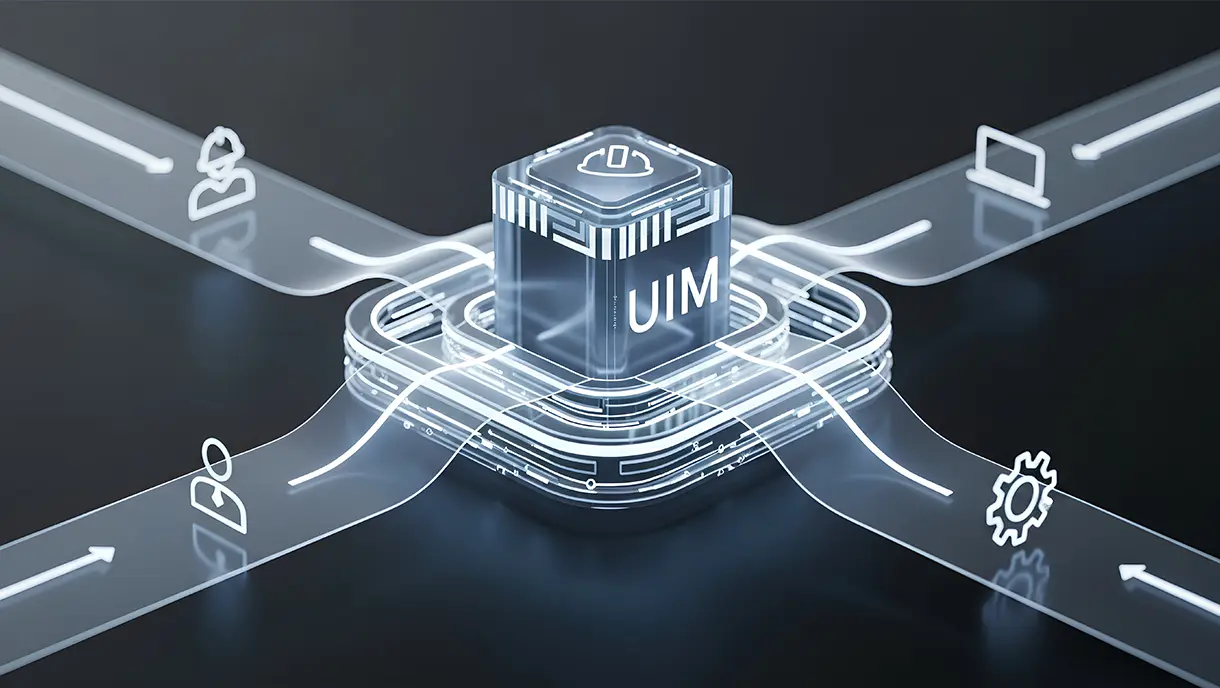
Get the latest updates! Subscribe now!




